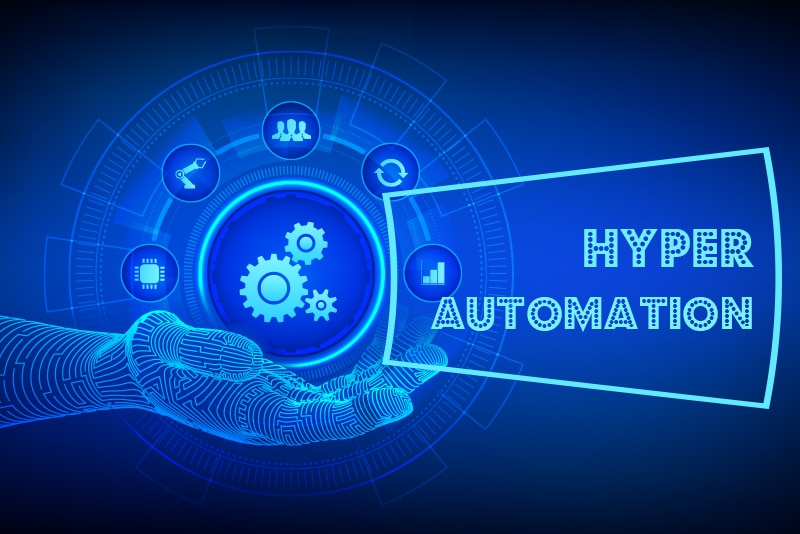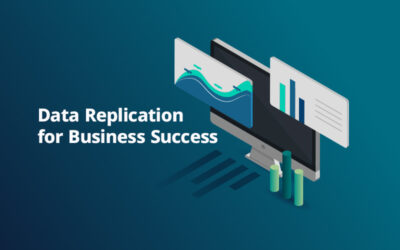Businesses across the world are looking out for innovative technologies to streamline existing business processes while continuing to deliver value to their customers. Amidst the continuous effort to handle pandemic-related changes, businesses are doubling down on scaling automation. IT leaders need to ensure that they select the right technologies that will perform business functions to be optimized. This is the crucial point wherein the significance of implementing a hyperautomation framework comes in. However, business organizations planning to incorporate hyperautomation technology into their organization need to understand exactly what the phrase refers to. In fact, the journey to complete automation can be realized with outsourcing services.
What Is Hyper Automation?
Continuing to grow in popularity, hyperautomation is present in “Gartner’s Top 10 Strategic Trends for 2022”. First introduced in the year 2019, hyperautomation has entered the enterprise lexicon and has evolved into more than a trendy catchphrase. The technology is slated to perform 69 percent of work currently performed by managers by 2024. According to Gartner, hyperautomation is “a business-driven, disciplined approach that organizations use to rapidly identify, vet and automate as many business and IT processes as possible.”
This supercharged automation strategy brings in a fresh burst of energy in to the existing initiatives by powering businesses by incorporating the choreographed use of several sophisticated tools, technologies or platforms like –
- Robotic Process Automation (RPA) -First gained its popularity in the early 2000s notably in the banking and financial sector, Robotic Process Automation is the best solution for implementing automation at scale. This is a platform where in automation engineers can develop and deploy bots.
- Artificial Intelligence (AI) – AI or artificial intelligence can be referred to as the simulation of human intelligence processes by using computer systems or machines. AI processes involves learning the programs by acquiring information from the given data, reasoning by consuming the instructions and information (thereby reaching conclusions) and correcting errors on its own by analyzing the successes and failures. However, if not implemented properly, the technology can be a building block of scaling automation. AI can only achieve peak optimization when supplied with a huge amount of good data. Most enterprises have this data, but much of it exists in unstructured format. AI can efficiently use unstructured data and use its own reasoning to execute the task.
- Low-Code Process Automation Platforms -If a business enterprise has some initial hyperautomation building blocks in place, low-code process automation platforms can resolve this by unlocking and capturing structured data. These low-code platforms can streamline data collection workflows. For instance, paper-based processes can be rapidly transformed into digital experiences, often with citizen developers (with no formal IT training) at the helm. Through the digital experience, organizations can ensure that error-free data is captured and passed on to systems down the line. This in turn minimizes the time and cost involved in executing a hyperautomation framework at scale.
- Process/Task Mining -This involves use of software that combs through event logs and finds undiscovered processes and process variants that may be suitable for automation.
- Process Modeling -This tool involves a centralized repository that can store all the data processes. In addition, it also provides a process editor that enables stakeholders to design and optimize the to-be automated processes. In addition, any robust process modeling solution allows connecting processes to all critical information like regulations, legacy systems, and more to facilitate change management and automation governance.
- Task Capture -A task capture tool may be used to define the flow employees follow to process invoices. Recorders sit on workers’ desktops and manually capture the processes and tasks that employees follow. This helps to identify good RPA opportunities and build the initial process for automation.
- Analytics and Reporting -Most RPA platforms provide monitoring and analytics features as this is the key aspect that help measure ROI and gain insight into the automated business processes like which processes are running the most, when, and which are error-prone?
Hyper Automation Trends to Know for 2022
Many organizations have already adopted hyperautomation tools, which is changing the way work gets performed. Over the next two years, experts forecast that every organization will actively use at least 3 out of 20 central processes that underpin hyperautomation. Here are the top hyperautomation trends to watch out in 2022 –
- Hyperautomation Goes Mainstream -As with most new technologies, hyperautomation has come into the scene among a handful of early adopters, mainly large enterprises ready to experiment with significant capital. However, as the technology evolved, costs slipped downward into the grasp of more budget-conscious SMEs. In order to meet the changing demands of small-to-medium businesses, hyperautomation providers are changing services into more affordable mini tools.
Hyperautomation tools like robotic process automation (RPA) can now be found in consumer operating systems and smartphones. iOS 15 can extrapolate text from a photograph. Windows 10 includes Power Automate Desktop for free, giving everyday PC users the tools to build powerful IFTTT automations. RPA has become so pervasive in certain sectors, that vendors now use it as a free appeal to bring in clients and hook them into other paid services.
- “Low-code” will trickle Down into Hyperautomation Skills -Among the non-IT personnel, business technologists are taking charge of the hyperautomation projects. In fact, business technologists now make up 41 percent of the workforce -an increasing number that showcases how in-demand hyperautomation skills are in today’s organizations. This team of technology leaders will need the tools and training to succeed. Hyperautomation vendors will provide low-code AI tools that offer casual business users greater access to machine learning models. Organizations will set forth more standardized training for teams of business technologists. Low-code tools will jump from a handy competitive advantage to an industry norm. It is estimated that by 2024, these easy, code-free tools will handle nearly 70 percent of development activity.
For instance, if an enterprise has some of the initial hyperautomation building blocks in place, low-code process automation platforms can connect everything together by unlocking and capturing structured data. These low-code platforms can streamline data collection workflows. For instance, paper-based processes can be rapidly transformed into digital experiences, often with citizen developers (with no formal IT training) at the helm.
- Commoditization of RPA -As RPA becomes an increasingly “entry-level” innovation, vendors are shifting their focus over to bulking up their top-tier offerings. They are racing to offer a comprehensive hyperautomation catalog to give customers a one-stop-shop for things like analytics, process mining, machine learning models, and more.
The consolidation of services will enhance both the quantity and quality of hyperautomation tools. This will result in low-code trends, making it easier than ever to integrate remarkably innovative hyper automation services.
- Hyperautomation will create a new era of “digital twins” –A digital twin duplicates business operations in the digital realm. Digital twins require a wealth of information to properly match real-world conditions, and hyperautomation is just the right data glutton to fuel the trend. Reports suggest that in the manufacturing industry, 65 percent of decision-makers expect to use hyperautomation to build digital twins of their operations in the coming years.
- Automation is Reimagining Teams -Even during the pandemic, automation has kept many businesses flexible. As many business organizations return to normal operations, they feel bothered by the increased presence of bots performing duties that used to belong to human staffers. Automation is expected to take over one in three jobs by 2025. But on the other side, artificial intelligence (AI) is expected to generate more jobs than it upends.
Gartner estimates that AI will create two million net-new jobs by the same year. These new positions will develop on both ends of the spectrum – in both highly skilled, vision-driven upper management and at the entry-level. Smart organizations are revisioning responsibilities to prepare their teams for the growing technology trends. Instead of seeing the hyperautomation software suite as a threat, it is important for organizations to start to train “fusion teams.” Fusion teams are multidisciplinary and hybrid teams that blend technology or analytics and business domain expertise and share accountability for business and technology outcomes. They are another building block for enterprises to ensure the success of project deployment. Similar to agile teams, fusion teams are made up of employees from a variety of departments. This allows the team to be more flexible and autonomous, and to drive faster digital delivery.
- Automation Looks Beyond Routine Tasks -Automation has been considered a boon for boosting the efficiency of repetitive, routine business tasks. However, business executives are exploring new ways on how hyperautomation can work alongside human thought leaders in non-routine tasks as well. Instead of mourning the loss of mundane, routine tasks to a bot, business organizations are engaging their teams to start thinking about the big questions they can pursue with the help of AI. A well-organized back office that can invoice, analyze, and report autonomously creates new opportunities for sales, client success, hospitality, and other roles that thrive with face-to-face communication.
AI activity shouldn’t be viewed as an adieu to human workers, but a way to infuse the human skillset with intel and insight impossible to gather through manual methods. This should serve as a wake-up call for organizations taking their time implementing hyperautomation.
- No Signs of Slowing Down – Hyperautomation is leading to significant business changes in 2022, with no signs of slowing down. With 80 percent of CEOs increasing spend on digital initiatives this year and 72 percent expecting to shorten the implementation timelines, adopting some of these building blocks can help in fast-paced business decisions backed by optimal data.
Hyperautomation prompts organizations to take a hard look at their processes to find creative opportunities for automation. Industry analysts predict that this trend will skyrocket to a staggering $46.4 billion by 2031. This growing trend can help streamline business processes to gather data and analyze it to make more informed decisions. To ensure the accuracy of business processes and data, organizations can rely on experienced business process outsourcing companies.




